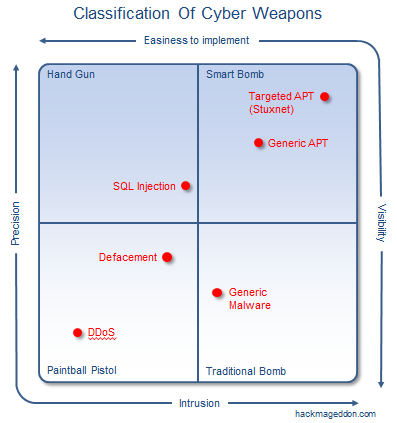We’ve been taking about Militarisation of cyberspace for some time now. This interesting article by Hackmageddon.com provides a model to classify cyber weapons in accordance with four parameters: Precision, Intrusion, Visibility, and Easiness to Implement. Based on these parameters, cyber threats can be compared to smart bombs, handguns, traditional bombs and paintball pistols. Read below to discover why.
What is a Cyber Weapon? At first glance this seems an immediate question to answer, but should anyone try to analyze the meaning of this term more deeply, he would probably be quite surprised and disappointed in discovering that the answer is not so immediate since an exact definition has not been given (at least so far).
A real paradox in the same days in which The Pentagon, following the Japanese Example, has unveiled its new strategy aimed to dramatically accelerate the development of new Cyber Weapons. And do not think these are isolated, fashion-driven examples (other nations are approaching the same strategy), but rather consider them real needs in the post-Stuxnet age, an age in which more and more government are moving their armies to the fifth domain of war [you will probably remember the (in)famous episode, when F-Secure was able to discover Chinese Government launching online attacks against unidentified U.S. Targets].
Recently Stefano Mele, a friend and a colleague of the Italian Security Professional Group, tried to give an answer to this question in his paper (so far only in Italian but it will be soon translated in English) where he analyzes Cyber Weapons from a legal and strategical perspective.
As he points out “Correctly defining the concept of Cyber Weapon, thus giving a definition also in law, is an urgent and unavoidable task, for being able to assess both the level of threat deriving from a cyber attack, and the consequent political and legal responsibilities attributable to those who performed it”. Maybe this phrase encloses the reason why a coherent definition has not been given so far: a cyber weapon is not only a technological concept, but rather hides behind its complex juridical implications.
According to Stefano’s definition: a cyber weapon is:
A device or any set of computer instructions intended to unlawfully damage a system acting as a critical infrastructure, its information, the data or programs therein contained or thereto relevant, or even intended to facilitate the interruption, total or partial, or alteration of its operation.
One could probably argue whether a cyber weapon must necessarily generate physical damages or not, in which case, probably, Stuxnet, would be the one, so far, to encompass all the requirements. In any case, from my point of view, I believe the effects of a cyber weapon should be evaluated from its domain of relevance, the cyberspace, with the possibility to cross the virtual boundaries and extend to the real world (Stuxnet is a clear example of this, since it inflicted serious damages to Iranian Nuclear Plants, including large-scale accidents and loss of lifes).
With this idea in mind, I tried to build a model to classify the cyber weapons according to four parameters: Precision (that is the capability to target only the specific objective and reduce collateral damages), Intrusion (that is the level of penetration inside the target), Visibility (that is the capability to be undetected), and Easiness to Implement (a measure of the resource needed to develop the specific cyber weapon). The results, ranging from paintball pistols to smart bombs, are summarized in the below chart.
Related articles
- What are Cyber-Weapons? (cyberarms.wordpress.com)
- Exclusive Infographic: all Cyber Attacks on Military Aviation and Aerospace Industry (theaviationist.com)
- Exclusive Infographic: All Cyber Attacks on Military Aviation and Aerospace Industry (hackmageddon.com)
- Drones used as Proxies to get around ISP blocking and law enforcement: Predator’s to add server payload? (theaviationist.com)
- After latest F-35 hack, Lockheed Martin, BAe Systems, Elbit under multiple cyber attacks….right now. (theaviationist.com)








